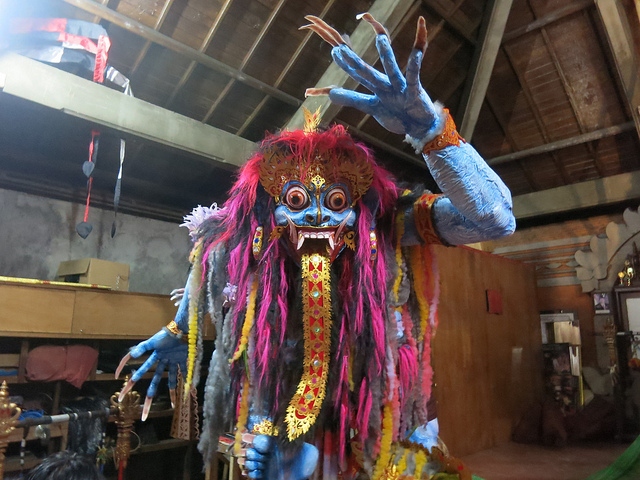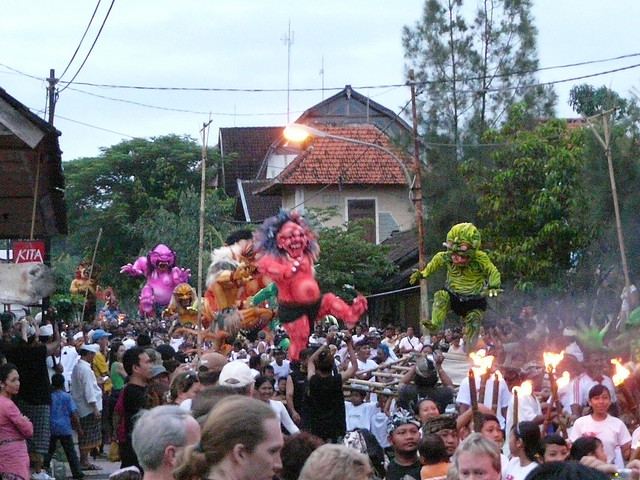Nyepi: Bali’s Day of Silence Posted by sasha on Mar 19, 2015 in Uncategorized
In a place as popular and bustling as the island of Bali, can you imagine experiencing absolute silence? No noisy motorbikes whizzing by, no TV sets blaring, no gossiping Balinese women chatting away, no beer guzzling backpackers partying on the beach. Absolute silence. This happens once a year on Hari Raya Nyepi, a Hindu celebration for the New Year according to the Balinese saka calendar. It falls on the first new moon in March, which happens on the 21st this year. Also known as the “Day of Silence,” this is a day for exactly that – reflection, fasting, and meditating. Here’s a rough guide to this important Balinese holiday:
A crash course in the “Day of Silence.”
The Days Before
In the days leading up to the festival, all of the statues of gods are taken out of temples and brought down to the water to be washed. In this colorful ceremony, sacred water is also collected. This ritual is known as melasti and is meant to purify the effigies.
Melasti ceremony in Bali.
On the day before Nyepi – Tawur Kesanga (“Day of Great Sacrifices”) – the Bhuta Yajna ritual takes place in villages all across the island. The purpose of this is to rid Bali of all evil spirits before the new year. Offerings are made by sacrificing animals, and huge monster-like dolls called ogoh-ogoh are made of paper-mache. With bulging eyes, creepy faces, and long claws, they are meant to terrify. After the monsters have been paraded through the village, they are burned in a ceremony known as Ngerupuk. From there, it degenerates into a wild party full of singing, dancing, and drinking.
Highlights from an ogoh-ogoh parade.
Nyepi
There aren’t any videos of the silence, so here’s another one of the parade.
Mere hours after the huge party, silence takes over the island at 6 in the morning and lasts for 24 hours. The reason for the peace and quiet is so that when the demons descend to take over Bali, they decide the island is uninhabited and leave it alone for one more year. All human activity ceases, and people must stay in their homes (or hotels for tourists). The only people you’ll see out on the streets are the pecalang (village police), who make sure nobody is out and about. There are four main rules, known as Catur Brata:
- Amati Geni: No fire, light, or electricity.
- Amati Karya: No working.
- Amati Lelungan: No movement or travel outside of the home.
- Amati Lelangunan: No entertainment or revelry of any kind.
This silence lasts until 6 AM the next day, when it’s back to business as usual on the Island of the Gods.
The Day After
The day of Ngembak Geni is a day to visit family, friends, and neighbors to ask for and exchange forgiveness for any wrongdoings in the past year. It’s also a day for religious Dharma Canthi rituals with the reciting of ancient scriptures. This is the equivalent of New Year’s Day in the Balinese calendar, but it’s much different from January 1st in western countries.
Bali is an island with a rich and fascinating culture, and the celebrations surrounding Nyepi are a prime example. If you should find yourself on the Island of the Gods around the New Year, join in the parade and debauchery, and then take a day to do as the Balinese do – reflect, meditate, and forego the usual pleasures of everyday life. For a closer look at this important holiday and some great Indonesian listening practice, check out this short documentary:

Build vocabulary, practice pronunciation, and more with Transparent Language Online. Available anytime, anywhere, on any device.
About the Author: sasha
Sasha is an English teacher, writer, photographer, and videographer from the great state of Michigan. Upon graduating from Michigan State University, he moved to China and spent 5+ years living, working, studying, and traveling there. He also studied Indonesian Language & Culture in Bali for a year. He and his wife run the travel blog Grateful Gypsies, and they're currently trying the digital nomad lifestyle across Latin America.





